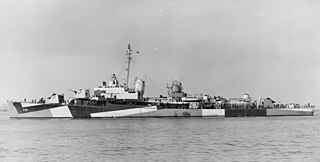
USS Barney (DD-956/DDG-6) was a Charles F. Adams-class guided missile destroyer in the United States Navy. She was the third Navy ship named for Commodore Joshua Barney USN (1759–1818).

USS Semmes (DDG-18), was the second Navy ship named for Commander (USN), Rear Admiral (CSN), Brigadier General (CSA) Raphael Semmes (1809–1877). Semmes was a Charles F. Adams-class guided-missile destroyer of the United States Navy. Entering service in 1962, Semmes spent most of her career in the Atlantic and Mediterranean theaters. Decommissioned in 1991, Semmes was transferred to the Hellenic Navy and renamed Kimon. The destroyer was decommissioned for the final time in 2004 and sold for scrap in 2006.

USS Little Rock (CL-92/CLG-4/CG-4) is a Cleveland-class light cruiser and one of 27 completed for the United States Navy during or shortly after World War II. She is one of six to be converted to guided missile cruisers and the first US Navy ship to be named for Little Rock, Arkansas. Commissioned in mid-1945, she was completed too late to see combat duty during World War II and was retired post-war, becoming part of the Atlantic Reserve Fleet in 1949.

USS Joseph P. Kennedy Jr. (DD-850) is a former United States Navy Gearing-class destroyer. The ship was named after Lieutenant Joseph P. Kennedy Jr., a naval aviator, son of the former U.S. Ambassador to Britain, Joseph P. Kennedy Sr., and older brother of future President John F. Kennedy. Joseph P. Kennedy Jr. served, with interruptions for modernization, until 1973. Among the highlights of her service are the blockade of Cuba during the Cuban Missile Crisis and the afloat recovery teams for Gemini 6 and Gemini 7. Joseph P. Kennedy Jr. is on display as a museum ship in Battleship Cove, Fall River, Massachusetts. She was added to the National Register of Historic Places in 1976, and designated a National Historic Landmark in 1989 as one of a small number of surviving Gearing-class destroyers.

USS Warrington (DD-843) was a Gearing-class destroyer that served the U.S. Navy from the end of World War II to the Vietnam War, when she was damaged by two underwater explosions, causing her to be listed as "beyond repair" and excessed to the Navy of the Republic of China.

USS Noxubee (AOG-56) was a Patapsco-class gasoline tanker acquired by the U.S. Navy for the task of transporting gasoline to warships in the fleet, and to remote Navy stations. She served in a commissioned status from 1945 to 1959, and 1965–1975. She was named for a river in Mississippi.

USS Charles H. Roan (DD-853) was a Gearing-class destroyer of the United States Navy. The ship was named after Charles Howard Roan, a United States Marine who lost his life in action on the island of Palau during World War II.

USS Zellars (DD-777), was an Allen M. Sumner-class destroyer that served in the United States Navy.

USS Willard Keith (DD-775), an Allen M. Sumner-class destroyer, is currently the only completed ship of the United States Navy ever named for Willard Keith, a United States Marine Corps captain who died in combat during the campaign for Guadalcanal. He was awarded the Navy Cross for his actions.

USS William R. Rush (DD/DDR-714) was a Gearing-class destroyer in the United States Navy. She was named for William R. Rush.

USS William M. Wood (DD/DDR-715) was a Gearing-class destroyer in the United States Navy during the final year of World War II. She was in commission for 31 years, from 1945 through 1976, serving in both the Pacific and Atlantic Fleets. She was the second Navy ship named for Navy Surgeon-General William M. Wood (1809–1880).

The third USS Lloyd Thomas (DD/DDE-764) was a Gearing-class destroyer in the United States Navy during the Korean War and the Vietnam War.

USS Basilone (DD/DDE-824) was a Gearing-class destroyer of the United States Navy, named for Gunnery Sergeant John Basilone (1916–1945), who was awarded the Medal of Honor for "extraordinary heroism and conspicuous gallantry in action...." in the defense of Henderson Field during the 1942 Guadalcanal campaign.

USS Shenandoah (AD-26) was one of ten planned destroyer tenders built at the tail end of World War II. The lead ship in her class, she was the third United States naval vessel named for the Shenandoah River which runs through Virginia and West Virginia.

USS Aylwin (FF-1081) was a United States Navy Knox-class frigate. She was the fourth vessel named for John Cushing Aylwin. Aylwin was laid down on 13 November 1969 at Westwego, La., by the Avondale Shipyard, Inc.; launched on 29 August 1970; sponsored by Mrs. Charles K. Duncan; and commissioned on 18 September 1971 at the Boston Naval Shipyard.

USS Yellowstone was a Shenandoah-class destroyer tender named for Yellowstone National Park, the second United States Navy vessel to bear the name.

USS Tidewater (AD-31) was a Shenandoah-class destroyer tender in service with the United States Navy from 1946 to 1971. She was transferred to the Indonesian Navy as KRI Dumai (652) and served until 1984, when she was scrapped.

USS Waccamaw (AO-109) was a Cimarron-class replenishment oiler in the United States Navy. She was named after Waccamaw River. The original capacity was 146,000 barrels (23,200 m3).

USS Sierra (AD-18) was a Dixie-class destroyer tender built just before the start of World War II for the U.S. Navy. Her task was to service destroyers in, or near, battle areas and to keep them fit for duty.

USS Yosemite (AD-19) was a Dixie-class destroyer tender built during World War II for the U.S. Navy. Her task was to service destroyers in, or near, battle areas and to keep them fit for duty.




















